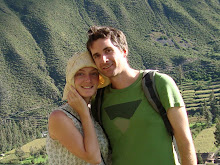
The night of Christmas Eve is the big Christmas celebration in Nicaragua. We spent it in a remote community at Melania's house with Nick and Rachel. We headed up into the hills in a pick-up truck full of presents for all the kids in the village. They all had a little bag stuffed full of things like water pistols, marbles, glowing sweets, rattles, imitation barbies, toy cars, headbands with feathers and balloons. The night before, there was a bag-stuffing party at Nick's to get it all sorted.

It's a fairly poor village so the kids wouldn't really get much else apart from this.
We arrived in time to witness the stuffing of the hens, which we were to eat at midnight. American Rachel took on the task of stuffing them which proved to be pretty tricky. Melania had removed all the meat and bones from the plucked hen but left the skin intact with just a slit down its breast.

The meat was cooked and then mixed up with oiled, uncooked rice, vegetables, a version of Worcestershire sauce and tomato ketchup. The whole lot was then stuffed back into the hen's skin and sewn up. After four hours in a big outdoor clay oven, the rice had expanded and the hen emerged looking like a plump roast chicken. We had to wait until midnight to get stuck in to platefuls of tasty hen and rice.

The early evening's entertainment got all the kids and women in the village involved in singing, pinatas and water balloon throwing.
 Simon controlling the pinata string while the little lad tries to whack the star with a stick and make sweets fall out.
Simon controlling the pinata string while the little lad tries to whack the star with a stick and make sweets fall out.  The water balloon game
The water balloon gameUnfortunately, most of the men and older teenage lads were already drunk by this point having spent most of the day gambling on the cock fight being held in the village.
As the sun went down, a lovely old man with a crinkly face and a twinkly smile donned a flashing Santa's hat, seated himself under a tree in the dusty main street under a lone light bulb powered by a little battery, and proceeded to give out around 100 presents.

After this, it was time for the disco, and the drunken lads and men swayed in to partner up with the ladies for a mixture of raggaeton, salsa and hopelessly slow ballads.
At midnight, we set off fireworks and distributed sparklers before retiring to Melania's house to finally tuck in to the hen.

 It was a lie-in for us on Christmas Day. We opened a few presents from our family, including chocolate and toffee, which we got stuck straight into, before getting up and eating delicious papaya, the rest of the hen from the night before and a ginger pudding with rum custard, which we had made in Leon and brought with us.
It was a lie-in for us on Christmas Day. We opened a few presents from our family, including chocolate and toffee, which we got stuck straight into, before getting up and eating delicious papaya, the rest of the hen from the night before and a ginger pudding with rum custard, which we had made in Leon and brought with us.  Diosmara and Carolina trying the pudding
Diosmara and Carolina trying the pudding It was the most refreshing swim we are ever likely to have on Christmas Day and great fun playing frisbee and leaping off rocks with the kids.
It was the most refreshing swim we are ever likely to have on Christmas Day and great fun playing frisbee and leaping off rocks with the kids.  On our return, we chopped up and scoffed an enormous watermelon.
On our return, we chopped up and scoffed an enormous watermelon. It was the most refreshing swim we are ever likely to have on Christmas Day and great fun playing frisbee and leaping off rocks with the kids.
It was the most refreshing swim we are ever likely to have on Christmas Day and great fun playing frisbee and leaping off rocks with the kids.  On our return, we chopped up and scoffed an enormous watermelon.
On our return, we chopped up and scoffed an enormous watermelon.



















































